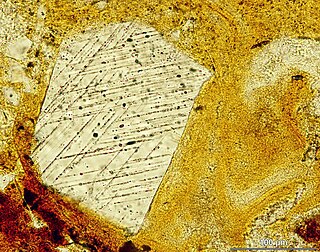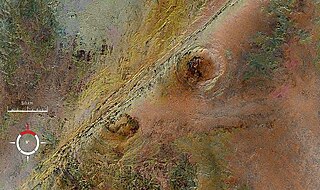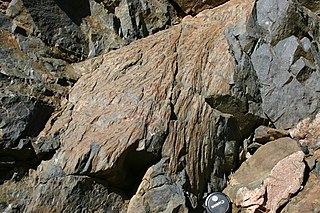
An impact crater is a circular depression in the surface of a solid astronomical object formed by the hypervelocity impact of a smaller object. In contrast to volcanic craters, which result from explosion or internal collapse, impact craters typically have raised rims and floors that are lower in elevation than the surrounding terrain. Lunar impact craters range from microscopic craters on lunar rocks returned by the Apollo program and small, simple, bowl-shaped depressions in the lunar regolith to large, complex, multi-ringed impact basins. Meteor Crater is a well-known example of a small impact crater on Earth.

Shocked quartz is a form of quartz that has a microscopic structure that is different from normal quartz. Under intense pressure, the crystalline structure of quartz is deformed along planes inside the crystal. These planes, which show up as lines under a microscope, are called planar deformation features (PDFs), or shock lamellae.

Coesite is a form (polymorph) of silicon dioxide (SiO2) that is formed when very high pressure (2–3 gigapascals), and moderately high temperature (700 °C, 1,300 °F), are applied to quartz. Coesite was first synthesized by Loring Coes, Jr., a chemist at the Norton Company, in 1953.

Impactite is rock created or modified by one or more impacts of a meteorite. Impactites are considered metamorphic rock, because their source materials were modified by the heat and pressure of the impact. On Earth, impactites consist primarily of modified terrestrial material, sometimes with pieces of the original meteorite.

The Arkenu structures, also known as the Arkenu craters, are a pair of prominent circular geological structures in eastern Libya. The structures are approximately 10 kilometres (6.2 mi) and 6.8 kilometres (4.2 mi) in diameter, and lie about 70 kilometres (43 mi) west of Jabal Arkanu on the eastern margin of the al-Kufrah Basin.

Keurusselkä is a lake in Central Finland between the towns of Keuruu to the north and Mänttä to the south. It covers an area of 117.3 km2 (45.3 sq mi). Its average depth is 6.4 m (21 ft) with a maximum depth of 40 m (130 ft). The surface lies at 105.4 m (346 ft) above sea level. The lake is 27 km (17 mi) long and is a part of the Kokemäenjoki water system. Keurusselkä gained international publicity in 2004 when a pair of amateur geologists discovered an ancient impact crater on the western shore of the lake.

Lappajärvi is a lake in Finland, in the municipalities of Lappajärvi, Alajärvi and Vimpeli. It is formed in a 23 km (14 mi) wide, partly eroded meteorite impact crater. The lake is part of Ähtävänjoki basin together with Lake Evijärvi that is located downstream (north) of it.
Suavjärvi is a lake in the Republic of Karelia, Russia about 50 km north of the town of Medvezhyegorsk. The lake is approximately 3 kilometers (1.9 mi) wide.

Shatter cones are rare geological features that are only known to form in the bedrock beneath meteorite impact craters or underground nuclear explosions. They are evidence that the rock has been subjected to a shock with pressures in the range of 2–30 GPa (290,000–4,350,000 psi).

Lechatelierite is silica glass, amorphous SiO2, non-crystalline mineraloid. It is named for Henry Louis Le Chatelier.

An impact structure is a generally circular or craterlike geologic structure of deformed bedrock or sediment produced by impact on a planetary surface, whatever the stage of erosion of the structure. In contrast, an impact crater is the surface expression of an impact structure. In many cases, on Earth, the impact crater has been destroyed by erosion, leaving only the deformed rock or sediment of the impact structure behind. This is the fate of almost all old impact craters on Earth, unlike the ancient pristine craters preserved on the Moon and other geologically inactive rocky bodies with old surfaces in the Solar System. Impact structure is synonymous with the less commonly used term astrobleme meaning "star wound".
Edward Ching-Te Chao was one of the founders of the field of impact metamorphism, the study of the effects of meteorite impacts on the Earth's crust.

The Santa Fe impact structure is an eroded remnant of a bolide impact crater in the Sangre de Cristo Mountains northeast of Santa Fe, New Mexico. The discovery was made in 2005 by a geologist who noticed shatter cones in the rocks in a decades-old road cut on New Mexico State Road 475 between Santa Fe and Hyde Memorial State Park. Shatter cones are a definitive indicator that the rocks had been exposed to a shock of pressures only possible in a meteor impact or a nuclear explosion.

Suevite is a rock consisting partly of melted material, typically forming a breccia containing glass and crystal or lithic fragments, formed during an impact event. It forms part of a group of rock types and structures that are known as impactites.

Seifertite is a silicate mineral with the formula SiO2 and is one of the densest polymorphs of silica. It has only been found in Martian and lunar meteorites, where it is presumably formed from either tridymite or cristobalite – other polymorphs of quartz – as a result of heating during the atmospheric re-entry and impact to the Earth, at an estimated minimal pressure of 35 GPa. It can also be produced in the laboratory by compressing cristobalite in a diamond anvil cell to pressures above 40 GPa. The mineral is named after Friedrich Seifert (born 1941), the founder of the Bayerisches Geoinstitut at University of Bayreuth, Germany, and is officially recognized by the International Mineralogical Association.

The c. 80 km x 40 km sized Rubielos de la Cérida structure is a claimed impact feature located in Aragon, northeast Spain, north of Teruel purported to have formed during the Upper Eocene or Oligocene. The name is derived from the nearby village of Rubielos de la Cérida. The claim that the structure represents an impact feature is rejected by the majority of scientists, and the mainstream consensus is that the supposed structure is explained by non impact related tectonic structures, namely the Jiloca-Calatayud graben and the Alfambra-Teruel graben.

Traces of Catastrophe: A Handbook of Shock-Metamorphic Effects in Terrestrial Meteorite Impact Structures is a book written by Bevan M. French of the Smithsonian Institution. It is a comprehensive technical reference on the science of impact craters. It was published in 1998 by the Lunar and Planetary Institute (LPI), which is part of the Universities Space Research Association (USRA). It was originally available in hard copy from LPI, but is now only available as a portable document format (PDF) e-book free download.

Meteorite shock stage is a measure of the degree of fracturing of the matrix of a common chondrite meteorite. Impacts on the parent body of a meteoroid can produce very large pressures. These pressures heat, melt and deform the rocks. This is called shock metamorphism. Meteorites are often given a rating from 1 to 6 showing the level of shock metamorphism. However, the degree of shock can vary within a meteorite on the scale of centimeters.
Bloody Creek crater, which is also known as the Bloody Creek structure, is a 420-by-350-meter in diameter elliptical feature that is located in southwestern Nova Scotia, Canada. It is argued to be either a possible extraterrestrial impact crater or an impact structure. It lies between Bridgetown and West Dalhousie, Annapolis County, Nova Scotia, where the Bloody Creek structure straddles what was once a stretch of Bloody Creek. It also is informally known as the Astrid crater.
Mineral alteration refers to the various natural processes that alter a mineral's chemical composition or crystallography.



















